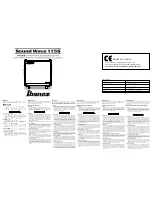
6
Features
Audio circuitry
At Linn, because we strive for continuous improvement in everything we do, we use appropriate
technologies to achieve our goals.
There have been many fine amplifier designs over the history of audio. Some use valves (tubes), some use
bipolar transistors, some MOSFETs. Some manufacturers swear by Class A, others by Class AB, one or two by
Class D, and many others are somewhere in between. Two designs can use the same components, but
achieve completely different results. We believe, and have evidence to support, that what you do with the
parts and technology is always much more important than the nature of the technology. To illustrate this,
our current power amplifier range contains MOSFET, monolithic, discrete and bipolar designs. Our latest
monolithic designs sound better than our previous discrete bipolar designs. Our latest bipolar designs have
more power and sound better than our earlier monolithic and bipolar designs.
So what did we choose for the KLIMAX CHAKRA 500 Twin?
For several years we have been designing and building power amplifiers using monolithic (single chip)
power devices. Monolithic circuits are, in principle, the optimum way to design the direct signal path
circuitry within a high-performance power amplifier. With a monolithic design, all the required audio
circuitry is contained within a few square millimetres of silicon, minimising circuit area for the shortest
possible signal path, making them inherently less susceptible to unwanted interference and enabling the
amplifier to operate at higher speeds. They also accommodate a circuit complexity which is not practical
with a discrete design and offer high-performance through tightly controlled and matched device
behaviours.
Unfortunately the investment required to design and manufacture these chips typically results in costs
which are prohibitive to short-run specialist applications such as high-end audio. Consequently they are
more often targeted at high-volume applications where audio performance is not the most important
parameter. For a number of years, Linn has worked closely with a trusted microchip manufacturer and as a
result of developing this relationship, exceptional capability has been designed into a high-volume chip,
enabling us to realise the potential of this technology without incurring unfeasibly high production outlay.
This aside, monolithic topologies do present a number of other technical challenges which, whilst not
insurmountable, can compromise the potential of the design. The most significant of these is output current,
which is limited due to both the compactness of the circuitry and the chip fabrication process, typically
resulting in unwanted distortion at high listening levels. Monolithic designs also have a tendency to be less
rugged than a well-crafted discrete design.
Summary of Contents for KLIMAX CHAKRA 500 Twin
Page 8: ......
Page 25: ...Pack 974 EF...











































